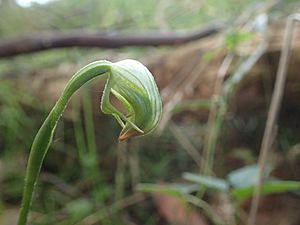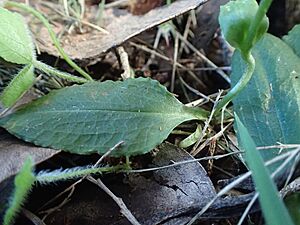Small nodding greenhood facts for kids
Quick facts for kids Small nodding greenhood |
|
|---|---|
 |
|
| Pterostylis hispidula growing near Ebor | |
| Scientific classification | |
| Genus: |
Pterostylis
|
| Species: |
hispidula
|
| Synonyms | |
|
Pterostylis nutans var. hispidula (Fitzg.) C.Moore & Betche |
|
The small nodding greenhood (scientific name: Pterostylis hispidula) is a special kind of orchid plant. It is also known as the box greenhood. This unique flower is found only in eastern Australia. Nodding greenhoods get their name because their flowers gently lean forward, almost like they are nodding! They have a special lip part called a labellum which is curved and a bit hairy. This orchid looks a lot like another one called Pterostylis nutans, but the small nodding greenhood is smaller. Its flowers also do not lean as far forward as the other species.
What Does the Small Nodding Greenhood Look Like?
The Pterostylis hispidula is a herb that grows from an underground tuber. This means it's a plant without a woody stem, and it comes back year after year. It also loses its leaves in some seasons (it's deciduous).
This orchid has a group of leaves that grow in a circle close to the ground. This is called a rosette. There are usually three to six leaves. Each leaf is shaped like an egg or an oblong. They are about 1 to 4 centimeters (0.4 to 1.6 inches) long and 0.5 to 1.5 centimeters (0.2 to 0.6 inches) wide. The leaves are green or yellowish. They often have wavy or crinkled edges and a clear leaf stalk, called a petiole.
A single flower grows on a tall stem. This stem can be 15 to 30 centimeters (6 to 12 inches) high. The flower itself is a see-through white color with green stripes. It often has a reddish tip. Just like its name suggests, the flower "nods" or leans forward. The flowers are about 1.4 to 1.8 centimeters (0.6 to 0.7 inches) long and 0.8 to 1 centimeter (0.3 to 0.4 inches) wide.
There's a wide space on each side of the flower. This space is between the petals and the side sepals. The side sepals have a pointy tip. They are about 0.5 to 0.8 centimeters (0.2 to 0.3 inches) long. There is a deep notch between them, called a sinus.
The special lip of the flower, the labellum, sticks out. It is about 0.9 to 1.2 centimeters (0.4 to 0.5 inches) long and 0.2 centimeters (0.08 inches) wide. This part is curved, dark in color, and covered with short, stiff hairs. This is where the name hispidula comes from! You can see these beautiful flowers from March to July.
How This Orchid Got Its Name
The small nodding greenhood was first officially described in 1880. A person named Robert D. FitzGerald gave it its scientific name, Pterostylis hispidula. He wrote about it after seeing it in places like Hunters Hill in Sydney and Springwood in the Blue Mountains.
The second part of its scientific name, hispidula, is a Latin word. It means "bristly," "rough," "hairy," or "prickly." This name perfectly describes the tiny hairs on the flower's labellum!
Where Does It Grow?
The Pterostylis hispidula orchid can be found in a wide area of eastern Australia. It grows from Fraser Island in Queensland all the way south to Batemans Bay in New South Wales. You can find it in many different places. It grows in coastal scrub, which is bushy land near the sea. It also lives on the edges of rainforests.



